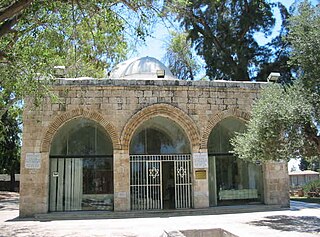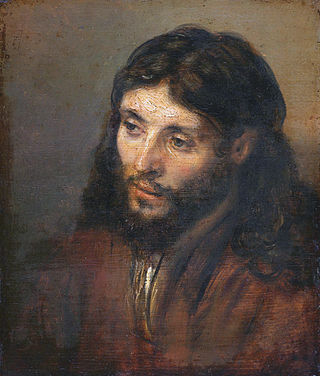Related Research Articles

Judah ha-Nasi or Judah I, known simply as Rebbi or Rabbi, was a second-century rabbi and chief redactor and editor of the Mishnah. He lived from approximately 135 to 217 CE. He was a key leader of the Jewish community in Roman-occupied Judea after the Bar Kokhba revolt.
Adherents of Judaism do not believe that Jesus of Nazareth was the Messiah nor do they believe he was the Son of God. In the Jewish perspective, it is believed that the way Christians see Jesus goes against monotheism, a belief in the absolute unity and singularity of God, which is central to Judaism; Judaism sees the worship of a person as a form of idolatry, which is forbidden. Therefore, considering Jesus divine, as “God the Son”, is forbidden. Judaism's rejection of Jesus as the Messiah is based on Jewish eschatology, which holds that the coming of the true Messiah will be associated with events that have not yet occurred, such as the rebuilding of The Temple, a Messianic Age of peace, and the ingathering of Jews to their homeland.

The Tosafot,Tosafos or Tosfot are medieval commentaries on the Talmud. They take the form of critical and explanatory glosses, printed, in almost all Talmud editions, on the outer margin and opposite Rashi's notes.
Yeshu is the name of an individual or individuals mentioned in rabbinic literature, thought by some to refer to Jesus when used in the Talmud. The name Yeshu is also used in other sources before and after the completion of the Babylonian Talmud. It is also the modern Israeli spelling of Jesus.
Bar Kappara was a Jewish scholar of the late second and early third century CE. He was active in Caesarea Maritima, the capital of the Roman province of Syria Palaestina, from around 180 to 220 CE. His name, meaning "Son of Qappara", was taken from his father, Eleazar ha-Kappar. He was one of the students of Judah ha-Nasi and a first-generation amora.

Tiberius Julius Abdes Pantera was a Roman-Phoenician soldier born in Sidon, whose tombstone was found in Bingerbrück, Germany, in 1859.

Rabban Gamaliel II was a rabbi from the second generation of tannaim. He was the first person to lead the Sanhedrin as nasi after the fall of the Second Temple in 70 CE.
Joshua ben Perahiah or Joshua ben Perachya was Nasi of the Sanhedrin in the latter half of the 2nd century BC.

Avodah Zarah is the name of a tractate of the Talmud, located in Nezikin, the fourth Order of the Talmud dealing with damages. The main topic of the tractate is laws pertaining to Jews living amongst Gentiles, including regulations about the interaction between Jews and "avodei ha kochavim", which literally interpreted is "Worshipers of the stars", but is most often translated as "idolaters", "pagans", or "heathen."
Eliezer ben Hurcanus or Hyrcanus was one of the most prominent Sages (tannaim) of the 1st and 2nd centuries in Judea, disciple of Rabban Yohanan ben Zakkai and colleague of Gamaliel II, and of Joshua ben Hananiah. He is the sixth most frequently mentioned sage in the Mishnah.
Joshua ben Hananiah, also known as Rabbi Yehoshua, was a leading tanna of the first half-century following the destruction of the Second Temple. He is the seventh-most-frequently mentioned sage in the Mishnah.
Eleazar ben Shammua or Eleazar I was a rabbi of the 2nd century, frequently cited in rabbinic writings as simply Rabbi Eleazar (Bavli) or Rabbi Lazar רִבִּי לָֽעְזָר (Yerushalmi). He was of priestly descent and rich, and acquired great fame as a teacher of traditional law.

Rabbi Haninah ben Teradion or Hananiahben Teradion was a rabbi and tanna of the third generation. He was a contemporary of Eleazar ben Perata I and of Halafta, together with whom he established certain ritual rules. Known as one of the wealthiest men in Galilee, he also served as the treasurer of a fund for the poor. Following the Bar Kokhba revolt, he was executed by the Romans for ignoring the ban on teaching Torah, and is considered one of the Ten Martyrs.
Sefer Toledot Yeshu, often abbreviated as Toledot Yeshu, is a medieval text which presents an alternative, anti-sectarian view, as well as a disputed biography of Jesus of Nazareth. It exists in a number of different versions, none of which is considered either canonical or normative within Rabbinic literature, but which appear to have been widely circulated in Europe and the Middle East in the medieval period. A 15th-century Yemenite version of the text was titled Maaseh Yeshu, or the "Episode of Jesus", in which Jesus is described either as being the son of Joseph or the son of Pandera. The account portrays Jesus as an impostor.
Jacob ben Abraham Faitusi was a Tunisian Jewish scholar. He settled in the later part of his life at Jerusalem, whence he was sent as a collector of alms to Italy and Algeria.
Gilyonim, or avon gilyon, are terms used by the Mishnah and Talmud to refer to certain heretical works.

Nazarene is a title used to describe people from the city of Nazareth in the New Testament, and is a title applied to Jesus, who, according to the New Testament, grew up in Nazareth, a town in Galilee, located in ancient Judea. The word is used to translate two related terms that appear in the Greek New Testament: Nazarēnos ('Nazarene') and Nazōraios ('Nazorean'). The phrases traditionally rendered as "Jesus of Nazareth" can also be translated as "Jesus the Nazarene" or "Jesus the Nazorean", and the title Nazarene may have a religious significance instead of denoting a place of origin. Both Nazarene and Nazorean are irregular in Greek and the additional vowel in Nazorean complicates any derivation from Nazareth.

There are several passages in the Talmud which are believed by some scholars to be references to Jesus. The name used in the Talmud is "Yeshu", the Aramaic vocalization of the Hebrew name Yeshua.
Opposition to Christianity in Chazalic literature consists of direct questioning and at times invalidating of Christianity as found in Chazalic literature. Of the notable reasons of Chazalic opposition to Christianity is that Christianity is founded on the belief of the Trinity, whereas Judaism follows the belief of unitarian monotheism. Another source of opposition is the belief that the Torah, as given by Moses, along with its interpretation by Chazal, is the supreme and exclusive indicator of Yahweh's instruction to Jews and mankind.
The Birkat haMinim is a curse on heretics which forms part of the Jewish rabbinical liturgy. It is the twelfth in the series of eighteen benedictions that constitute the core of prayer service in the statutory daily 'standing prayer' of religious Jews.
References
- ↑ Jehiel ben Joseph of Paris, Vikuakh, ed. R. Margaliot, Lemberg (1928)
- ↑ Steinsaltz The essential Talmud - Page 105 2006 "Wherever the Talmud makes derogatory reference to Jesus or to Christianity in general, the comment was completely erased, and the name of Christ was systematically removed, even when the reference was not negative."
- ↑ Thiessen and Merz draw on Dalman (1893), Maier (1982), and Thoma (1990) in reaching this conclusion. Theissen, Gerd and Annette Merz. The historical Jesus: a comprehensive guide. Fortress Press. 1998. translated from German (1996 edition). p. 74-76.
- 1 2 Jeffrey Rubenstein Rabbinic Stories (The Classics of Western Spirituality) New York: The Paulist Press, 2002
- ↑ Daniel Boyarin, Dying for God: Martyrdom and the Making of Christianity and Judaism Stanford: Stanford University Press, 1999
- ↑ R. Travers Herford, Christianity in Talmud and Midrash (London: Williams & Norgate, 1903)